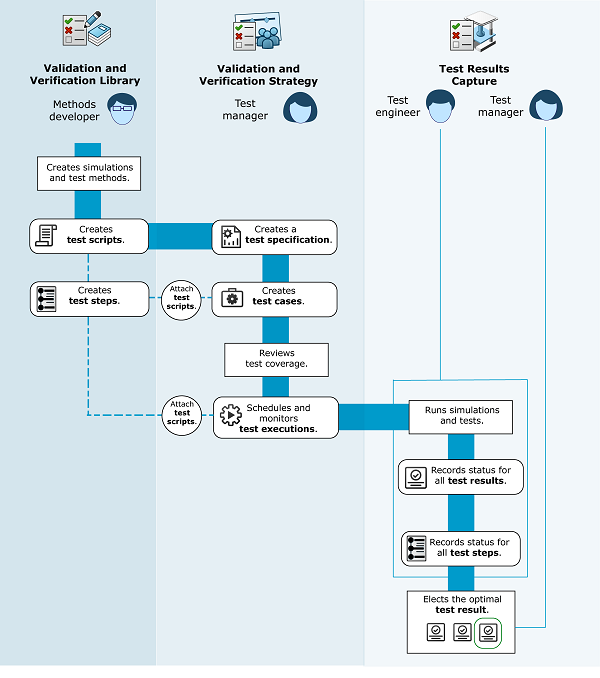Test Management Workflow | ||
| ||
The
Validation and Verification Strategy, Validation and Verification Library, and Test Results Capture apps each provide an integral part of the testing process, as illustrated below:
A methods developer with the Author role creates and manages the maturity of reusable test scripts throughout the testing cycle. These test scripts contain the instructions for implementing a test. These instructions can be further broken down into test steps. The methods developer creates the test scripts with Validation and Verification Library:
- Create one or more test scripts to be used as instructions for performing the validation tests. Link test script data to each test script you create. Test script data is any asset required for testing. For example, test script data may take the form of a simulation template, a Word document that contains instructions for testing and may contain scripts like Python, Perl, or batch files. For more information, see Creating Test Scripts.
- Change the maturity level of the test script. When you first create the test script, the test script is in the Private state (not visible to other users). While working on the script, promote the script to InWork to allow others access and editing privileges. When the test script is ready for review, move the test script from InWork to Frozen. For more information, see Changing the Test Script Maturity Level.
A test manager with the Leader role establishes the overall strategy for validating and verifying a set of requirements. Test managers create test specifications, test cases, and test executions with Validation and Verification Strategy. In addition, the test manager identifies gaps in test coverage and schedules and monitors the tests and simulations:
- Review the test scripts and change the maturity level of the test scripts from the Frozen to the Released state. Only released test scripts can be used with test cases. For more information, see Changing the Test Script Maturity Level.
- Create a test specification to define the overall process and strategy for testing a system. Link a project to the test specification. For more information, see Validation and Verification Strategy User's Guide: Creating Test Specifications.
- Create test cases to define scenarios for validating system requirements. Attach test scripts to the test cases. For more information, see Validation and Verification Strategy User's Guide: Creating Test Specifications.
- Review test coverage.
- Create test executions to plan virtual or physical tests. Select test scripts to run during the test executions. At this time, you can also assign a responsible engineer to perform the tests. For more information, see Validation and Verification Strategy User's Guide: Creating Test Executions.
- Assign a responsible engineer to perform the tests. For more information, see Validation and Verification Strategy User's Guide: Assigning Test Executions.
- Schedule the assigned tests.
- Monitor the progress of test executions and maturity of the design.
The test engineer runs the simulations and tests assigned to them. The test engineer records the final status for all test results with the Test Results Capture app:
- Run all assigned simulations and tests.
- Record the final status of each test. Test status may be Incomplete, Passed, or Failed. For more information, see Test Results Capture User Guide: Creating Test Results.
Once the final status is recorded, the test manager elects the optimal test result that satisfies the test requirements:
- From the tests that passed, determine which tests best fulfill the test requirements.
- Elect the optimal test result. For more information, see Test Results Capture User Guide: Electing a Final Test Result.